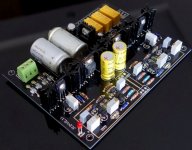This is Yucky. He lives in the top bathroom. He's 6 feet tall.
An externally hosted image should be here but it was not working when we last tested it.
Done that. Stupid time now. I'm restoring an apogee ribbon tweeter. As its a ribbon, things recorded on a ribbon mic will sound better played back through a ribbon.
Or have I been wrong assuming these things are commutative all these years ? 😉
No, you are right on of course.
And of course you found one of the couple of documents that do talk about it, by B&K, who are the only people who talk about it.And yet a single google query gives me this http://www.bksv.com/doc/083-80.pdf which shows how B&K recomment measuing non-linearity. I am sure if i tried harder there would be decade of stuff from them. After all they make test instruments not musical instruments...
Note that the focus is on high pressure behaviour, the "mounted on the edge of a bit of drum kit" location, not what happens in a normal recording environment. In fact, that is what the literature is about - what happens in extreme recording situations.
Note that there is no information actually available, for a person who wants a microphone, about what its distortion behaviour is. Caveat emptor ... perhaps, buy an expensive unit, subject it to some tests, then take it back and claim a refund because it's not up to scratch ...
Interesting, I see the BSP reading rising a touch more ...
Deviations from flat are due to impedance changes or mismatch--- Z vs distance/time. Check with Tek or HP literature on how to cal., use and interpret the measurement.
Being the test equipment junky that I am, I have and use the TEK 7S12 plug-in with S6 and S52; A 25ps system. Not a current model... newer models exist....but works fine.
THx-RNMarsh
Absolutely right.
The manufacturer closed their plant in Chicago-ish and moved it South. The before the move cable is flat, the after the move cable isn't.
I do not read the bumps as uniform. I see two periodic issues. So while dropping a spool might be an issue these spools are not exactly small. (1500' put up of .475" diameter cable at 200 LB.s per spool.)
I read it as the center conductor is not staying centered on two axis!
Each bump is about a 5% mismatch of the nominal 75 ohm cable.
Quote:
Originally Posted by SY
"Spectrally similar to a school bus."
That may be a useful description where you live, but over here school buses can come in any colour - and yellow is quite rare. Context is everything!
... with all colors of the spectrum, from infra-dead to ultra-violent...
Hitchhikers guide to the galaxy, describing a Vogon attack.
Gerhard (catching up on the thread..)
How are you connecting the TDR and end termination, and more particularly how are you connecting the second shield ?.Interesting idea, but no this is unspooled! Same as when on the spool and I have four of them.
Dan.
This is Yucky. He lives in the top bathroom. He's 6 feet tall.
An externally hosted image should be here but it was not working when we last tested it.
My previous indoor Yukkas got too leggy. I'm on cuttings off them now. That is a fine specimen.
Hmmm, how were the reels transported....standing on side cheek, or laying flat on edges of the side cheeks ?.Absolutely right.
The manufacturer closed their plant in Chicago-ish and moved it South. The before the move cable is flat, the after the move cable isn't.
I do not read the bumps as uniform. I see two periodic issues. So while dropping a spool might be an issue these spools are not exactly small. (1500' put up of .475" diameter cable at 200 LB.s per spool.)
I read it as the center conductor is not staying centered on two axis!
Each bump is about a 5% mismatch of the nominal 75 ohm cable.
What temperatures have the reels been subjected to ?.
I have had troubles with tv coax that was oval shaped.
Not sure if it was squashing due to transport, or wound onto the reel whilst still overly warm and compliant, or wound too tightly and taking that 'set'.
Dan.
Well guys, I have been shown a REAL FIND in audio preamps and I actually have one to test. It is made in China, called a JC-2, because it has copied the original Levinson JC-2 line stage, sometimes talked about and built here. It has an R-core 30W transformer AND some sort of regulated power supply,(more later on that), 3 double pole quality relays for line switching, and multiple multi-turn pots for offset, and bias adjust. It also has a 2 channel Alps (blue) pot. WOW! There is NO WAY we could make and sell this for under $1000 or so. Guess what? It costs $126+$30 shipping. The case is well made, (not Blowtorch quality) but very nice, with a milled front panel and off-on switch in front with an led indicator. (more later)
Last edited:
It is the right preamp, but a different vendor, apparently. We paid $30 for shipping, I am pretty sure. There IS a 110V version as well. That is what I have. It has what appears to be 2sk170-J74 differential pairs in each channel. All discrete. No obvious problems.
Here's a close-up of the PCB, its selling quite well over here (36 shifted in recent weeks) on Taobao, price about $100. PCB alone, go here ($25) - ·ÂJC-2Ç°¼¶Ì×¼þ ºÚ½ðÖÕ¼«°æ±¾ ´ø3λÊäÈëÑ¡Ôñ-ÌÔ±¦Íø
Attachments
Last edited:
I thought it would have more compromises. OF COURSE, it is compromised somewhat in several ways, but they would be subtle, and usually fixable, if someone found it important enough.
- Status
- Not open for further replies.
- Home
- Member Areas
- The Lounge
- John Curl's Blowtorch preamplifier part II

 .
.